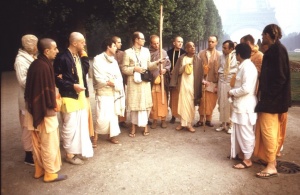CC Adi 4.181 (1975): Difference between revisions
(Vanibot #0027: CCMirror - Mirror CC's 1996 edition to form a basis for 1975) |
(Vanibot #0020: VersionCompareLinker - added a link to the Version Compare feature) |
||
| Line 2: | Line 2: | ||
<div style="float:left">'''[[Sri Caitanya-caritamrta (1975)|Śrī Caitanya-caritāmṛta (1975)]] - [[CC Adi (1975)|Ādi-līlā]] - [[CC Adi 4 (1975)|Chapter 4: The Confidential Reasons for the Appearance of Śrī Caitanya Mahāprabhu]]'''</div> | <div style="float:left">'''[[Sri Caitanya-caritamrta (1975)|Śrī Caitanya-caritāmṛta (1975)]] - [[CC Adi (1975)|Ādi-līlā]] - [[CC Adi 4 (1975)|Chapter 4: The Confidential Reasons for the Appearance of Śrī Caitanya Mahāprabhu]]'''</div> | ||
<div style="float:right">[[File:Go-previous.png|link=CC Adi 4.180 (1975)|Ādi-līlā 4.180]] '''[[CC Adi 4.180 (1975)|Ādi-līlā 4.180]] - [[CC Adi 4.182 (1975)|Ādi-līlā 4.182]]''' [[File:Go-next.png|link=CC Adi 4.182 (1975)|Ādi-līlā 4.182]]</div> | <div style="float:right">[[File:Go-previous.png|link=CC Adi 4.180 (1975)|Ādi-līlā 4.180]] '''[[CC Adi 4.180 (1975)|Ādi-līlā 4.180]] - [[CC Adi 4.182 (1975)|Ādi-līlā 4.182]]''' [[File:Go-next.png|link=CC Adi 4.182 (1975)|Ādi-līlā 4.182]]</div> | ||
{{CompareVersions|CC|Adi 4.181|CC 1975|CC 1996}} | |||
{{RandomImage}} | {{RandomImage}} | ||
==== TEXT 181 ==== | ==== TEXT 181 ==== | ||
| Line 11: | Line 10: | ||
<div class="verse"> | <div class="verse"> | ||
:tabe ye dekhiye gopīra nija-dehe prīta | :tabe ye dekhiye gopīra nija-dehe prīta | ||
:seho | :seho ta' kṛṣṇera lāgi, jāniha niścita | ||
</div> | </div> | ||
| Line 18: | Line 17: | ||
<div class="synonyms"> | <div class="synonyms"> | ||
tabe—now; ye—whatever; dekhiye—we see; gopīra—of the gopīs; nija- | tabe—now; ye—whatever; dekhiye—we see; gopīra—of the gopīs; nija-dehe—in their own bodies; prīta—affection; seho—that; ta'-certainly; kṛṣṇera lāgi—for Lord Kṛṣṇa; jāniha—know; niścita—for certain. | ||
</div> | </div> | ||
| Line 25: | Line 24: | ||
<div class="translation"> | <div class="translation"> | ||
Now, whatever affection we see the gopīs show | Now, whatever affection we see the gopīs show in their own bodies, know it for certain to be only for the sake of Lord Kṛṣṇa. | ||
</div> | </div> | ||
| Line 32: | Line 31: | ||
<div class="purport"> | <div class="purport"> | ||
The selfless love of Godhead exhibited by the gopīs cannot have any parallel. We should not, therefore, misunderstand the carefulness of the gopīs in their personal decoration. The gopīs dressed themselves as beautifully as possible just to make Kṛṣṇa happy by seeing them. They had no ulterior desires. They dedicated their bodies, and everything they possessed, to the service of Śrī Kṛṣṇa, taking | The selfless love of Godhead exhibited by the gopīs cannot have any parallel. We should not, therefore, misunderstand the carefulness of the gopīs in their personal decoration. The gopīs dressed themselves as beautifully as possible, just to make Kṛṣṇa happy by seeing them. They had no ulterior desires. They dedicated their bodies, and everything they possessed, to the service of Śrī Kṛṣṇa, taking for granted that their bodies were meant for His enjoyment. They dressed themselves on the understanding that Kṛṣṇa would be happy by seeing and touching them. | ||
</div> | </div> | ||
Latest revision as of 17:43, 26 January 2020

A.C. Bhaktivedanta Swami Prabhupada
TEXT 181
- tabe ye dekhiye gopīra nija-dehe prīta
- seho ta' kṛṣṇera lāgi, jāniha niścita
SYNONYMS
tabe—now; ye—whatever; dekhiye—we see; gopīra—of the gopīs; nija-dehe—in their own bodies; prīta—affection; seho—that; ta'-certainly; kṛṣṇera lāgi—for Lord Kṛṣṇa; jāniha—know; niścita—for certain.
TRANSLATION
Now, whatever affection we see the gopīs show in their own bodies, know it for certain to be only for the sake of Lord Kṛṣṇa.
PURPORT
The selfless love of Godhead exhibited by the gopīs cannot have any parallel. We should not, therefore, misunderstand the carefulness of the gopīs in their personal decoration. The gopīs dressed themselves as beautifully as possible, just to make Kṛṣṇa happy by seeing them. They had no ulterior desires. They dedicated their bodies, and everything they possessed, to the service of Śrī Kṛṣṇa, taking for granted that their bodies were meant for His enjoyment. They dressed themselves on the understanding that Kṛṣṇa would be happy by seeing and touching them.